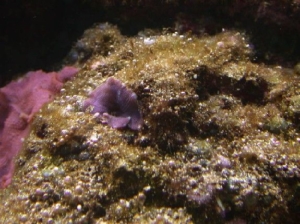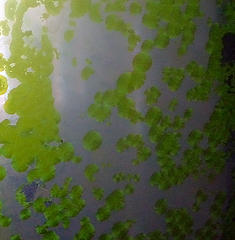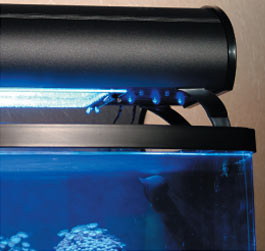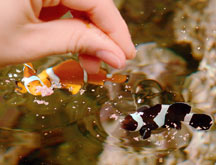Algae growth in your saltwater aquarium is natural. They can either be good or bad depending on whether or not they become unmanageable and get out of control.

Pros and cons in your saltwater aquarium will be covered in this section. We’ll also learn about their different types, including those that you want to keep.
What are algae?
They are photosynthetic organisms that occur throughout the work in many habitats ranging from fresh water to salt water and from the poles to the equator.
They are simple organisms that range in size from the one-celled microscopic types to large seaweeds that grow to over 230 feet.
They are also hardy organisms that have a tremendous reproductive capacity.
They can enter your aquarium as algal spores borne by the air or carried by tank furnishing from another aquarium.
The term alga is singular, and more than one alga is called algae.
They have adapted to all kinds of water conditions. They are important as primary producers at the base of the food chain. They provide oxygen and food for aquatic life but some contributes to mass mortality of other organisms. In some regions, coralline algae can be as dominant as corals in the formation of reefs.
They can be planktonic, meaning they float freely in the ocean and when they do they are called microalgae . The term seaweed refers to larger species of called macroalgae , that live in the marine environment attached to the bottom.

In your aquarium, they can be found on the waters surface, suspended in the water, or on the surfaces of the aquarium glass, rocks, gravel, coral, and decorations.
Many are introduced on live rock or coral, but some enter your aquarium with water from other aquarium and as spores.
For all their diversity, they have one thing in common: Light and nutrients are the key conditions they survive in.
Whether or not they are plants, they act like them. They need light to grow just like your favorite flower or backyard tree does. And like the flower and tree, nutrients like nitrates and phosphates are the fertilizers that form their building blocks.
Here is a helpful article understanding what phospate really is.
Strong lighting and nitrate from the nitrogen cycle let them grow. This is why during these cycle days, blooms are very common.
They are also photosynthetic so they use carbon dioxide and convert it into oxygen. They need light to photosynthesize and at night they respire and produce carbon.
Routinely scraping some (not all) of them in your saltwater aquarium, you are physically getting nitrates, phosphates and other nutrients out.
Well looks like some are good for a saltwater aquarium.
But why do a lot of people think that they are a nuisance?
Many hobbyists think that a sterile looking aquarium is clean and healthy. They remove as much of them as they can all the time to keep the aquarium looking clean. Well, next time you go snorkeling or diving in the ocean, look closely at the rocks, coral and sand. Youll see them literally covering all the exposed surfaces.
So, I assume you are getting what I mean! They are an important part of the natural coral reef ecosystem. Many of the fish and invertebrates feed on them alone. Get used to seeing them and promoting their growth in your saltwater aquarium. But remove some of it routinely to maintain a clear view of your vibrant saltwater fishes.
When They Get Out of Control
At some point, they will get out of control. Excessive amount consumes oxygen during the night and covers live corals and live rock. They clog the filtration system and are very unsightly to your vision.
When you experience algae bloom, it is a sign that something is wrong in your aquarium. Remember that they need light and nutrients to survive so check on these factors when they become a nuisance.
Light
Try to set your aquarium far from where there is a direct sunlight. Keep natural lighting under control. Keep the lights on 10-14 hours for planted aquariums and 6-10 if you only have ornament set ups. Also, use only aquarium lamps! Other fluorescent limited spectrum of light invites outbreak. And change the bulbs frequently. As these bulbs ages, they lose their spectrum and intensity. Once the spectrum changes, unwanted growth will be expected.
Keep natural lighting under control. Keep the lights on 10-14 hours for planted aquariums and 6-10 if you only have ornament set ups. Also, use only aquarium lamps! Other fluorescent limited spectrum of light invites outbreak. And change the bulbs frequently. As these bulbs ages, they lose their spectrum and intensity. Once the spectrum changes, unwanted growth will be expected.
Nutrients
Its favorite nutrient is phosphate. Remove it by using phosphate No products found. .
Another source of nutrients is when you overfeed your saltwater fish, corals and other inhabitants you may have in your aquarium. It will be helpful to just feed once a day to avoid and to control its growth.
I would also recommend more plants so that there will be less chance of them taking over your saltwater aquarium. Plants compete with them for light and nutrients. They most often win if they have the proper conditions.
Know Your Algae
The following are the ones that you are most likely will encounter:
- Chlorophyta or Green Algae
- Rhodophyta or Red Algae
- Phaeophyta group – Brown Algae
- Diatoms
- A group of bacteria called the Cyanobacteria – Blue-green Algae
* Disclaimer: Saltwater-Aquarium-Online-Guide.com is a participant in the Amazon Services LLC Associates Program, an affiliate advertising program designed to provide a means for sites to earn advertising fees by advertising and linking to amazon.com, amazon.co.uk, amazon.ca. Amazon and the Amazon logo are trademarks of Amazon.com, Inc. or its affiliates. We may receive a small commission if you click on one of our links and make a purchase. Thank you for supporting Saltwater-Aquarium-Online-Guide.com and helping me make it the best site possible!
Last update on 2024-04-23 / Affiliate links / Images from Amazon Product Advertising API



